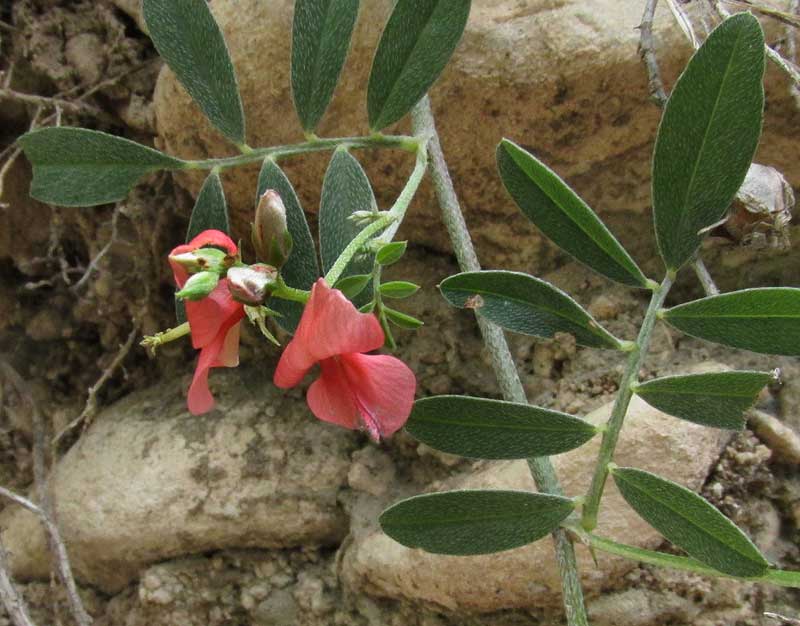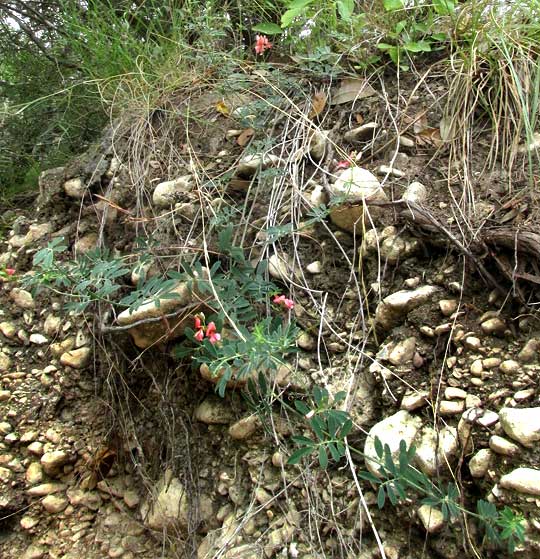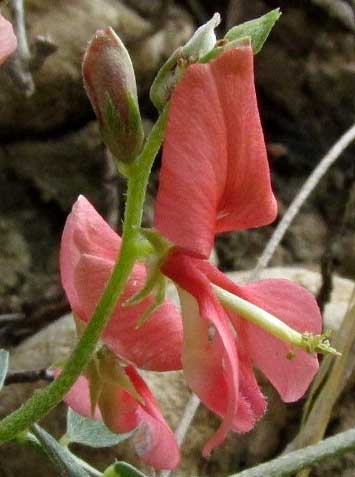Excerpts from Jim Conrad's
Naturalist Newsletter

from the September 7, 2014 Newsletter issued from the Frio Canyon Nature Education Center in the valley of the Dry Frio River in northern Uvalde County, southwestern Texas, on the southern border of the Edwards Plateau; elevation ~1750m (~5750 ft); N29.62°, W99.86°; USA
COASTAL INDIGO
Dangling from the dry top edge of a roadcut through a geologically old deposit of mixed limestone cobbles and silt, a wiry stem with pinnately compound leaves bore several small, salmon-pink flowers, as shown below:

The pinnately compound leaves immediately suggest the big Bean Family. At the top of this page you have a closer look showing how they are heavily invested with sharp, pale hairs held against the leaves' surface.
Even closer, the flowers display the typical Bean Family "papilionaceous" structure -- a conspicuous top petal, two side petals or "wings," and two lower petals fused along their common margin to form a scoop-shaped "keel," and- confirms the Bean Family for us. A flower close-up appears below:

In that picture, notice how the whitish filaments of this flower's ten stamens unite to form a cylinder around the pistil's long style, except for one stamen that's held apart, visible in our photo. Such 9+1 stamen arrangement is widespread in the Bean Family. Stamens arranged in this manner are said to be "diadelphous."
The flower's upward-jutting top petal, its side petals' or wings' of a much narrower-than-usual width, and the long, straight cylinder formed by the diadelphous stamens reminded me very much of Lindheimer's Indigo, common here in cobblestone fields along the Dry Frio. But Lindheimer's Indigo is more bushy and upright, and the flowers are different colored, even if their structure is similar. For the pleasure of enjoying the "variation on a theme" effect, you might enjoy comparing our above flower picture with a similar close-up of a flower of the Lindheimer's Indigo at http://www.backyardnature.net/n/13/130811ip.jpg.
So, the short story is that this is a different species of "wild indigo" -- another species of the genus Indigofera. It's INDIGOFERA MINIATA, variously known as the Coastal Indigo, Texas Indigo, Western Indigo and Scarlet Pea. Indigo dye, so important to our ancestors, was produced by several species in the genus Indigofera, but our Coastal Indigo is surely too small and spindly for that purpose.
Coastal Indigo occurs from Guatemala all through Mexico, and in the US is fairly common on well-drained sand, loam, clay and caliche in Texas, Oklahoma and southern Kansas, and spottily along the Gulf Coast and throughout Florida. Though I don't often see it in the Dry Frio Valley, the Wildflower.Org website reports it as abundant in open areas of the eastern two thirds of Texas. Coastal Indigo is further said to be relished by deer and grazed by livestock, so maybe that accounts for its uncommonness here, where White-tail and Axis Deer are grossly overpopulated.
The seeds, or beans, of Coastal Indigo are eaten by Bobwhite and Mourning Doves. Among butterfly caterpillars feeding on the leaves are the larval stages of the Gray Hairstreak, Common Dogface, and Reakirts Blue.